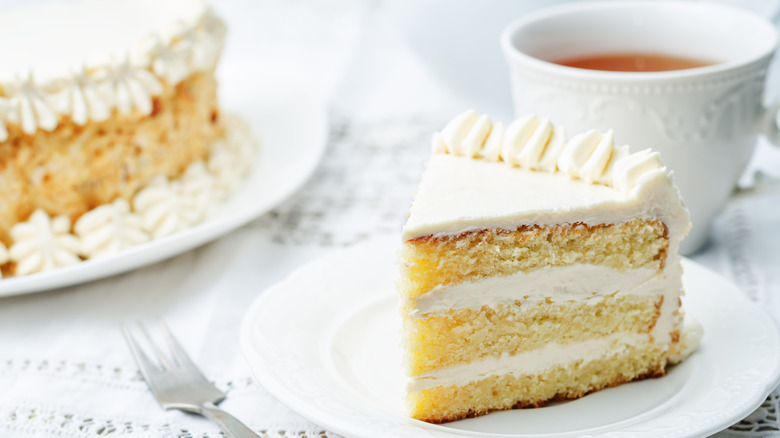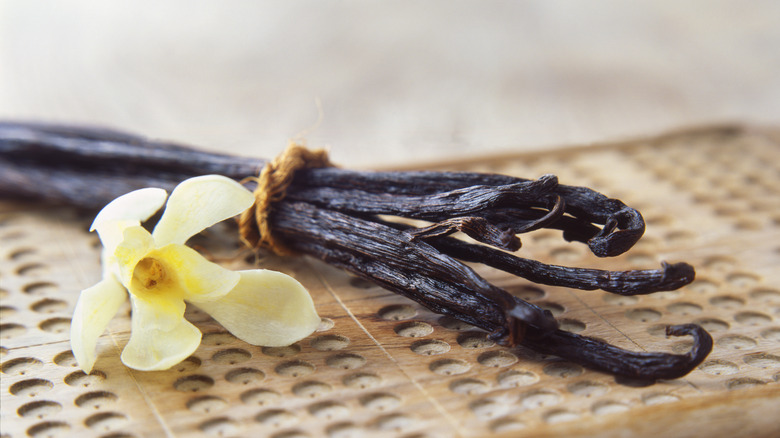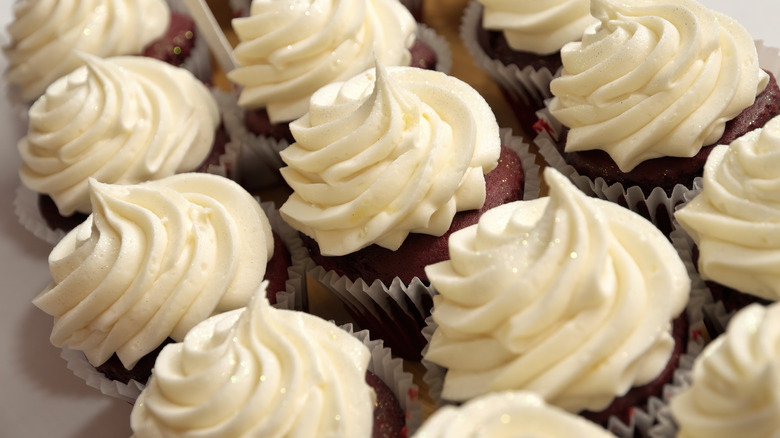Bean, Paste, Or Extract: What's The Best Vanilla For Your Cake?
Vanilla is a baking staple that comes in a variety of different types. The ingredient is required in nearly every dessert recipe, whether it is a no-bake banana pudding or a layered birthday cake. The flavor is subtle, yet it elevates sweet treats by adding a delicious aroma and taste that doesn't distract from the other flavors in the recipe. The ingredient is versatile in both its use and its form. With vanilla bean, vanilla extract, and vanilla paste all on the market, how do you know which is best to use in your cake recipe?
First, all the different types of vanilla are just slight variations of each other. While each one has its strengths, they can all be used as substitutions for one another. However, there are instances when vanilla bean or paste would deliver better results than extract in recipes, and vice versa.
Vanilla bean is the most natural way to add vanilla flavor, and it packs a strong taste. Meanwhile, vanilla paste and extract are both diluted versions of the beans. Therefore, pure vanilla bean is highly recommended for cake recipes that rely on its strong vanilla flavor, while the extract is best used in recipes that require a splash of the vanilla to enrich other flavors, like in a chocolate cake or a carrot cake. Continue reading for the ultimate breakdown of what type of vanilla to use in cake batters and frostings.
What type of vanilla should you use in your cake batter?
Vanilla is derived from a flower called the vanilla orchid. Once the thin, brown vanilla pods are extracted from the flower through a labor-intensive process, they are cured — as a form of food preservation — and dried. Then, they are ready to be used for baking. The whole vanilla bean can be split open lengthwise to reveal its vanilla seeds, which can be scrapped out and added to recipes directly.
Vanilla beans can be made into a paste when the seeds are blended with vanilla extract and sugar syrup. This results in a strong vanilla taste with a kick of sweetness. Both the beans and the paste leave behind black specks that carry the intense vanilla flavors. Paste is often used in recipes that, like the beans, require a heavy focus on the vanilla flavor. Given its thick texture, it is also best used in recipes that have a creamy finish, like a vanilla cheesecake or whipped cream. Lastly, vanilla extract is the result of soaking vanilla beans in alcohol and using the leftover liquid. It does not contain any actual vanilla and it delivers a more subtle taste.
Any of the vanilla types can be used in cake batter recipes, but if you are looking for a stand-out vanilla flavor, beans or paste are your best bet. Extract, on the other hand, is best used in recipes with multiple flavors, as it pairs well with others.
Which vanilla type is best for cake frosting?
Vanilla paste's thick texture and desirable vanilla flavor make it the perfect choice for vanilla frosting, especially if the frosting needs to maintain its shape for decorating. Vanilla beans can also be useful in frosting recipes, though the paste will be sweeter and doesn't need to be manipulated. However, both will leave behind black specks. So, if you are looking to create a pure-white frosting, either as the final product or as a base for colorful frosting, vanilla extract is the optimal choice since it won't leave behind any residue. The extract is also useful for thin icings, since it comes in a liquid form. To get the most out of the extract, be sure to use a pure vanilla, rather than an imitation variety.
Now, there are several reasons why one may have multiple types of vanilla in their kitchen. Some folks are baking on a budget and will settle on extract for most things, then splurge on the paste or the beans for special occasions. Vanilla extract is typically the cheapest of the three because it's mass-produced and has a seemingly indefinite shelf life. Meanwhile, vanilla paste has a shelf life of about three years and vanilla beans should be used within eight months.
Thankfully, the different types can easily be swapped out for one another. ½ of a vanilla bean pod is equal to 1 teaspoon of paste or extract. You can use a 1-to-1 ratio to substitute paste for extract and vice versa.


